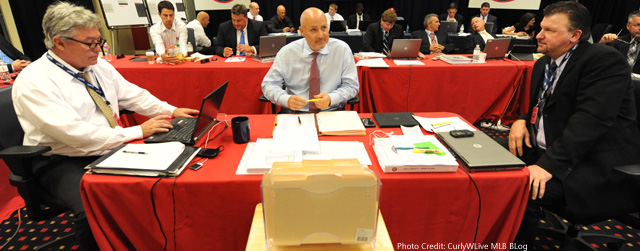
There are four major figures that have great influence over the Nationals draft: General Manager Mike Rizzo, Scouting Director Kris Kline, Director of Player Procurement Kasey McKeon, and Assistant GM and VP of Player Personnel Roy Clark, .
Mike Rizzo – Executive Vice President of Baseball Operations and General Manager
Our fearless leader since Jim Bowden’s resignation in March of 2009, Mike Rizzo is still an interesting specimen from a drafting perspective. He previously served as the Arizona Diamondbacks’ Scouting Director from 2000 to 2006. Overall (between both Arizona and DC), Rizzo has leaned heavily towards college players (75% of top 10 round picks) and pitchers (60%).
Kris Kline – Scouting Director
Kline was promoted by the Nationals to Scouting Director in 2009 after serving as Assistant Scouting Director and National Crosschecker in 2009 and originally joined the Nats in 2006 from Arizona. There’s unfortunately not a whole lot of information out there concerning Kline (or McKeon for that matter) that I could create any useful conclusions from.
Kasey McKeon – Director, Player Procurement
The son of legendary manager Jack McKeon and a former minor-league catcher, Kasey served as the scouting director for Cincinnati from 2001-02 and was an assistant to Rockies GM Dan O’Dowd for seven seasons up until being named Nationals Director of Player Procurement in 2011. While in Cincinnati, the top 10 rounds of his drafts leaned towards college players (67%) and pitchers (57%).
Roy Clark – Assistant General Manager and Vice President, Player Personnel
Clark served as the Atlanta Braves’ scouting director from 2000 up until being named Nationals Assistant GM and VP, Player Personnel in 2009. He is credited for procuring many top Braves talents (past and present) such as Brian McCann, Tommy Hanson, Adam Wainwright and Jason Heyward. While in Atlanta, the top 10 rounds of his drafts were pitching heavy (61%) but pretty even between college (55%) and high schoolers (45%). The number dropped drastically over the years, too, with only 22% of his top 10 draftees coming out of high school in his last three years in Atlanta.
I recently read Scout’s Honor by Bill Shanks, essentially an account of how the Braves scouted their way to the top of the NL East. While it was written in 2005, there is still plenty of good intel inside, including an entire chapter dedicated to Roy Clark. One of the major philosophies that Clark stressed in Atlanta is thorough scouting. He is not afraid to go off the board for a player he likes (similar with Rizzo with Jordan Zimmermann). That’s how Clark got Kevin Millwood in the eleventh round in 1993. Other teams lost interest in Millwood when his velocity was down at the beginning of his senior year in high school, but Clark knew it was because that Millwood had been playing on his school’s basketball team and couldn’t make it to baseball workouts. It worked out pretty well, as in the eleventh round of the 1993 draft, the other three guys to reach the big leagues (Glen Barker, Steve Rain and Tom Fordham) combined for -0.7 WAR in their careers. 2011 Nats tenth-rounder RHP Manny Rodriguez is a recent example of a pick based more on scouting, as he is a converted third baseman coming from a small school (Division II Barry University) who is still learning how to pitch.
Clark also emphasizes the importance of makeup, which he defined in Scout’s Honor as “the guy you want at home plate with the game on the line and he wants to be there.” He ties it in with the thorough scouting point as well, noting that “to get a good read on a kid’s makeup you can’t see him just one game or one time… I like to see a guy at his best and I like to see a guy at his worst. I like to see how he handles adversity.”
The book in general is a bit of a crusade against Moneyball, but Clark seems to lie somewhat in the middle of the stats vs. scouting argument. Excellent stats will get a player noticed by Clark quicker and mediocre stats will cause red flags, but neither will make or break a player’s draft status in Clark’s eyes. He uses himself as an example, as he was the MVP on his high school team over Lou Whitaker, who went on to enjoy an 18-year MLB career full of all-star appearances and gold gloves. I personally side with this philosophy (to some degree at least) because quality of competition and small sample sizes can skew the stats of both high school and college players alike.
The last major point Clark makes about the draft revolves around signability. The process of signing draftees has significantly changed in the seven years since the book was published, but the idea of it remains the same: Do these players want to be Washington Nationals? If yes, draft them. If no, do not. Clark’s philosophy does not suggest chasing guys with signability question marks, Matt Purke not withstanding.
Next week: A look at some potential targets for the Nationals in the 2012 Draft
